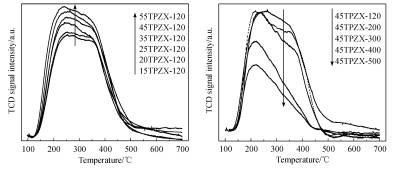化学学报 ›› 2011, Vol. 69 ›› Issue (16): 1881-1889. 上一篇 下一篇
研究论文
梁丽萍1,2,朱晴1,赵永祥*,1,刘滇生*,1
Liang Liping1,2 Zhu Qing1 Zhao Yongxiang*,1 Liu Diansheng*,1

采用过量浸渍结合溶剂蒸发将12-磷钨杂多酸(TPA)分散于水合ZrO2干凝胶表面(以TPA质量分数表示的固载量为5~65 wt%), 再经120~500 ℃空气气氛焙烧得到水合ZrO2固载磷钨杂多酸催化剂. 借助等离子体原子发射光谱(ICP-AES)、物理吸附、X射线衍射(XRD)、傅里叶变换红外(FTIR)光谱、吡啶吸附红外(Py-IR)光谱以及氨程序升温脱附(NH3-TPD)等手段对催化剂的组成、结构及酸性质进行表征, 针对四氢呋喃(THF)开环聚合考察其酸催化性能. 研究表明, 在适宜的TPA固载量(35~45 wt%)及活化温度(120~300 ℃)条件下, TPA主要以畸变但结构未遭破坏的Keggin物种高度分散于水合ZrO2表面, 赋予催化剂合适的酸性质及优良的催化性能. 当TPA固载量过高时, 部分TPA以体相物种析出|而当固载量过低或活化温度过高时, TPA的部分Keggin结构会发生分解. 体相物种在THF极性体系中的严重溶脱或Keggin结构分解引起的酸性位大量丧失都使得材料的催化性能大幅度下降. 催化剂重复使用实验显示, TPA固载量为45 wt%、300 ℃活化的催化剂具有良好的稳定性.